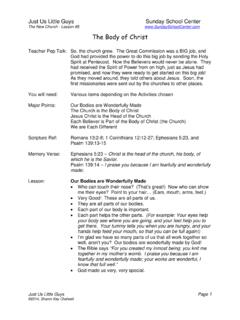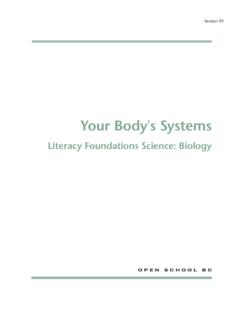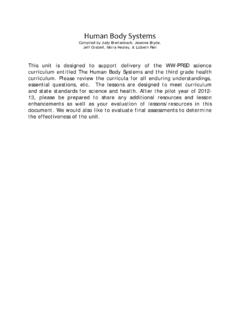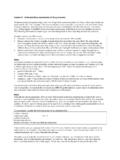Transcription of Detailed Lesson Plan—Kindergarten Body Parts (Language …
1 Detailed Lesson Plan Kindergarten body Parts (Language and Culture) Page 1 of 9 Topic: body Parts Grade Level: Kindergarten Estimated Time Required: 30 minutes/ day. It lasts for 2 weeks. Learning Objectives: The students have the ability 1) Name 9 body Parts .[Knowledge] [Intrapersonal Communication] 2) Know the Panda bear. [Comprehension] [Culture][Connection] 3) Perform singing the song: Panda bears. [Synthesis] [Presentational Communication] 4) Describe I have two eyes and one nose. [Analysis] [Presentational Communication] 5) Apply/ Ro le play My belly hurt [Application] [Interpersonal Communication] Content: Key Vocabulary Nose, eyes, ears, mouth, head, hands, belly, legs, and feet.
2 Sentence Pattern 1. This is my nose. 2. I have one nose. I have two eyes. 3. My belly/ hurts. Grammar 1. Chinese has measure words between numbers and nouns. For example, instead of saying yi(1) bizi(nose),we need to say yi ge bizi (1+measuer word+nose). Ge is a measure word. 2. While we count er for number 2, such as yi, er, san (1, 2, 3), we use liang instead of er when the number comes with a noun. Assessments: Observational (Checklist) Differentiated Instruction: Discussion [logical-mathematical] Teacher s Instruction [logical-mathematical] Games [Bodily-Kinesthetic] TPR [Bodily-Kinesthetic] [Visual] Projects [Bodily-Kinesthetic] Group work+ pair work [Interpersonal] Compet it ion [Interpersonal], Role-plays [Interpersonal] Videos [Visual] Songs [Musical] Reading [Verbal/Linguistic] Online games [Intrapersonal] Learning outcomes: Song, role-play, project, presentation Resources & Materials: Books Better Chinese.
3 Chinese Treasure Chest Detailed Lesson Plan Kindergarten body Parts (Language and Culture) Page 2 of 9 Worksheet Online games Flashcards DVD Hello, China No. 90 Crayons Day 1 ACTIVITIES CONTENT PROCESS Connection Review the colors from previous unit: Panda bear s co lor 1. Bring a panda bear toy to share. Ask the students what color is the panda s eyes, ears, belly, hands, and feet. 2. Summarize them in Chinese and have the students to listen to the words. Tell them we are coming to learn the body Parts . Game Introduction to nose, eyes, mouth, and ears. 1. The students play the game with me. They put their fingers on their noses first. I say nose, nose, nose. They point at their nose.
4 I say nose, nose, eyes. They point at their eyes. When they play, they need to say the words with me. 2. We play this for three times. Then the students face their partners and see who is faster. 3. We closed our eyes and see if the students can figure out by themselves. (It is easy for me to observe how well the students can identify the words through listening.) TPR Scaffo lding Group work Learn the words: Nose, eyes, mouth, and ears. 1. Ask the students to say these words with me and point at them. 2. I point at my own nose/eyes/mouth/ears, and ask them to say what body Parts I am pointing. 3. Have 2 or 3 students to be the teacher and play this game. 4. Have students work in a group of 4 and take turns to check on others.
5 Singing Introduction to a song. 1. Listen to me sing the song: Giant panda. Giant panda, giant panda, (you have) black eyes and big body . (You) swing your body when you walk. We all love you. 2. Have the students to hum and dance with me. Day 2 ACTIVITIES CONTENT PROCESS Detailed Lesson Plan Kindergarten body Parts (Language and Culture) Page 3 of 9 Game Group work Review nose, eyes, mouth, and ears. Play the game again: nose, nose, nose. 1. Practice for several times and have the students to close their eyes and play it. 2. Have the students to play in a group of 4. They take turns to be the teacher to say nose, nose, nose . 3. Have 2 or 3 students to be the teacher and say nose, nose, nose while others point at their noses.
6 4. I point at my nose/eyes/mouth/ears. They need to name them. 5. Have students work in a group of 4. They take turns to be the teachers and the rest of them need to say the body Parts . Singing Learn the song: Giant Panda The students are already familiar with the melody from yesterday s hum and dance. 1. Take out some pictures of panda bear. Ask what they can see from the panda bear: eyes, nose, mouth, ears, legs, arms, hands, feet, belly. 2. Ask them if they have seen panda bear before. Introduce that panda bears only live in China. Chinese people send panda bears to other countries as gift. Panda bear is considered to be a symbol of peace and friendship. 3. Listen to the song: Giant panda.
7 Ask them if they can understand some words, such as giant panda (we mentioned that before), black eyes, love. 4. Ask them to repeat with me sentence by sentence. Have a competition to see if boys or girls learn fast. (Just a way to motivate the students to focus.) 5. Have some students to sing and dance with me in front of others. 6. Have several groups to sing for others. TPR Wrap-up and learn a little bit about next class. 1. Review nose, eyes, mouth, and ears. 2. Have the students to do this with me and prepare for the next class: Clap your hands, touch your belly, touch your Detailed Lesson Plan Kindergarten body Parts (Language and Culture) Page 4 of 9 head, touch your leg, and stamp your feet.
8 Day 3 ACTIVITIES CONTENT PROCESS TPR Learn head, hands, belly, leg, and feet. TPR: clap your hands. 1. Have the students to stand up and do some actions with me: clap your hands, touch your belly, touch your head, touch your leg, and stamp your feet. 2. Have students to practice for several times and have them to close their eyes to do it. I remind them when they finish their action, such as Did you clap your hands just now? Is that touch your belly? Game Compet it ion Group work Learn head, hands, belly, leg, and feet. 1. Have students to sit in a big circle, so we can all see each other. 2. Have students to say head/hands/belly/leg/feet with me and tap their body Parts when they say them.
9 3. Remind them that belly is duzi, starts with a D. Bunny is tuzi (they learned bunny before), starts with a T. So the students can remember both words and pay attention to the consonant. 4. Have the students to repeat faster and faster. 5. I point at a body part and have them to say it out. 6. Have a boy challenge a girl/ or a girl challenge a boy. I point at a body part , and see if the boy/ or the girl can say it out first. 7. Have the students to work in a group of 4. I assign them with the first caption. The caption point at his/her body part , the first team member say it out will be the next caption to point at his/her body part . I just walk around to see if any team needs help. Singing and Dancing Song: giant panda 1.
10 Have students review the head/hands/belly/leg/feet for the last time. 2. Ask the students if they still remember the song: Giant Panda. 3. Ask the students to sing with me if they still remember. Detailed Lesson Plan Kindergarten body Parts (Language and Culture) Page 5 of 9 4. Ask them to sing with panda bear s voice (low and bold), dance like a panda bear (big, furry, and heavy). 5. Have some students to perform to sing and dance like a panda bear. Day 4 ACTIVITIES CONTENT PROCESS Singing Song: Giant Panda 1. Ask them to sing the song: Giant Panda with the piano. (I shared a room with music, so I have a piano in the classroom). 2. Ask them to sing faster and faster, slower and slower, higher and higher, lower and lower.

![Human Body Systems | 5E Lesson Plan for Grades 3-5 [PDF]](/cache/preview/5/3/7/d/5/f/0/a/thumb-537d5f0a980c7ec9133056914a11eb75.jpg)




